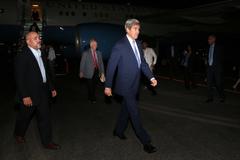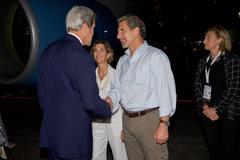
Visiting Rafael Núñez International Airport Cartagena De Indias Colombia: Tickets, Hours, and Expert Tips
Date: 14/06/2025
Introduction
Rafael Núñez International Airport (IATA: CTG) serves as the main gateway to Cartagena de Indias, Colombia—a city celebrated for its UNESCO-listed colonial walled city, vibrant Caribbean culture, and thriving tourism industry. Conveniently located just 3 km from Cartagena’s historic center, the airport connects millions of travelers annually to both domestic and international destinations. As Colombia’s third-busiest airport, it plays a pivotal role in the region’s economic and cultural landscape, supported by continuous modernization and expansion efforts.
This comprehensive guide details the airport’s history, current operations, ticketing and transportation options, expansion plans, and nearby attractions. Whether you’re arriving for business or leisure, understanding Rafael Núñez International Airport’s facilities, services, and its role in Cartagena’s development will enrich your travel experience. For the latest updates, refer to official resources such as the Rafael Núñez International Airport website and Cartagena Tourism Official Site (Wikipedia; Medellin Guru).
Contents Overview
- History and Evolution of Rafael Núñez International Airport
- Visiting Hours and Ticketing Guide
- Transportation and Accessibility
- Highlights of Cartagena’s Historical Sites
- Guided Tours and Photography
- Airport Expansion and Future Plans
- Sustainability and Community Engagement
- Frequently Asked Questions (FAQ)
- Summary & Travel Advice
- Useful Links and Official Sources
1. History and Evolution of Rafael Núñez International Airport
Early Beginnings
Aviation in Cartagena began in 1920 with the Bocagrande airfield, managed by the Compañía Colombiana de Navegación Aérea (CCNA). A landmark event was Charles Lindbergh’s 1928 landing during his famous Latin American tour (Wikipedia). After CCNA’s closure, SCADTA (Sociedad Colombo-Alemana de Transporte Aéreo) opened the Manzanillo Island aerodrome in 1930, which eventually became part of Avianca’s network.
The Crespo Era and Modernization
The post-war aviation boom led to the opening of the Crespo Air Field in 1946, ultimately consolidated by Avianca in the 1950s. Administration changes and infrastructure improvements followed, culminating in the construction of a new passenger terminal and runway extension in 1982. The airport was renamed Rafael Núñez International Airport in 1986, honoring Cartagena-born former president and national anthem lyricist Rafael Núñez (Cartagena Explorer; Wikipedia).
Concessions and Growth
In 1996, airport operations were privatized under a concession managed by SACSA and AENA, leading to significant upgrades and capacity expansion. By 2022, Rafael Núñez International handled over 7.2 million passengers, firmly establishing itself as a regional leader (Medellin Guru).
2. Visiting Hours and Ticketing Guide
Visiting Hours
Rafael Núñez International Airport is open 24 hours a day, 7 days a week, providing flexibility for travelers on early morning or late-night flights. Airline check-in hours and specific services may vary; confirm with your carrier in advance (AirportsData).
Ticketing Information
- How to Buy Tickets: Purchase directly from airline websites, travel agencies, or at the airport’s ticket counters.
- Airlines: Major carriers include Avianca, LATAM Colombia, Delta Air Lines, Plus Ultra Líneas Aéreas, JetSmart, Wingo, and Viva Colombia.
- Recommendation: Book flights in advance, especially during peak tourist seasons, for the best fares and availability.
3. Transportation and Accessibility
Getting To and From the Airport
- Taxis: Readily available 24/7 outside terminals; fares to the city center range from COP 15,000–25,000.
- Hotel Shuttles: Many hotels offer pre-arranged shuttle transport.
- Public Buses: Limited routes; best suited for light travelers.
- Car Rentals: Several agencies on-site.
- Ride-Sharing: Services like Uber may be available.
- Accessibility: The airport is equipped with ramps, elevators, accessible restrooms, and assistance for travelers with reduced mobility.
4. Highlights of Cartagena’s Historical Sites
Rafael Núñez International Airport is ideally positioned for exploring Cartagena’s renowned attractions:
- Walled City (Ciudad Amurallada): Stroll through colorful colonial streets and plazas in this UNESCO World Heritage site.
- Castillo San Felipe de Barajas: Explore the fortress’s tunnels and walls for a glimpse into Cartagena’s military past.
- Palacio de la Inquisición: Visit this museum for artifacts from colonial history.
- Convento de la Popa: Climb to Cartagena’s highest point for panoramic views.
All these sites are within a short drive from the airport.
5. Guided Tours and Photography
Numerous guided tours are available from the airport or city center, including walking tours, boat trips to surrounding islands, and immersive cultural experiences. For photography enthusiasts, the Getsemaní neighborhood, city walls at sunset, and airport vicinity provide stunning backdrops.
6. Airport Expansion and Future Plans
Current Expansion Projects
To accommodate growing demand, a major expansion is set to begin in March 2025 with a 1.2 trillion COP investment (Aviacionline). Key features:
- New 17,360 m² international terminal
- 2,814 m² of remodeled existing terminal space
- Expanded commercial platform and parking
- Additional runway infrastructure
- Job creation for over 400 people
- Projected annual passenger capacity exceeding 8 million
Future Airport in Bayunca
Long-term plans include a new airport in Bayunca, projected for up to 11 million passengers annually and an estimated cost of 4.5 billion COP. Construction may start as early as 2026 (FL360aero).
7. Sustainability and Community Engagement
Expansion projects integrate environmental safeguards: sustainable building materials, energy-efficient design, water conservation, and recycling. Community consultations and accessibility improvements ensure social responsibility and inclusivity.
8. Frequently Asked Questions (FAQ)
Q: What are the airport’s visiting hours?
A: Open 24 hours daily.
Q: How do I buy flight tickets?
A: Online via airline websites, travel agents, or airport counters.
Q: Is the airport accessible for travelers with reduced mobility?
A: Yes, with dedicated facilities and assistance.
Q: What transport options connect the airport to the city?
A: Taxis, hotel shuttles, limited public buses, car rentals, and ride-sharing.
Q: Which historical sites are close to the airport?
A: The Walled City, Castillo San Felipe de Barajas, Palacio de la Inquisición, and Convento de la Popa.
9. Summary & Travel Advice
Rafael Núñez International Airport is more than a travel hub—it’s a symbol of Cartagena’s transformation and connectivity. Its 24/7 operations, modern amenities, and proximity to cultural sites make it a top choice for exploring Colombia’s Caribbean coast. With ongoing expansions and sustainable practices, the airport is set to meet the needs of future travelers while preserving Cartagena’s unique heritage.
Travel Tips:
- Visit December–April for the best weather.
- Use official taxis or pre-arranged transfers.
- Wear comfortable shoes for city exploration.
- Download the Audiala app for real-time updates, airport guides, and local tours.
10. Useful Links and Official Sources
- Official Rafael Núñez International Airport Website
- Cartagena Tourism Official Site
- Cartagena Explorer Airport Guide
- Medellin Guru Cartagena Airport Overview
- Castillo San Felipe de Barajas - Cartagena Tourism
- Aviacionline News
- InfraPPPWorld Expansion News
- FL360aero New Airport Article
- Wikipedia - Rafael Núñez International Airport
For more travel insights, download the Audiala app and follow our updates for the latest on Cartagena’s airport, city events, and historical tours. Safe travels!



